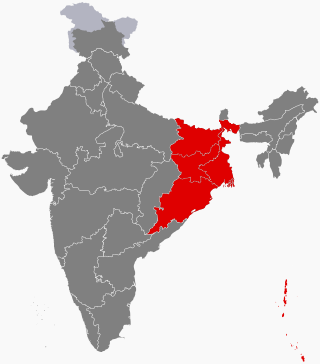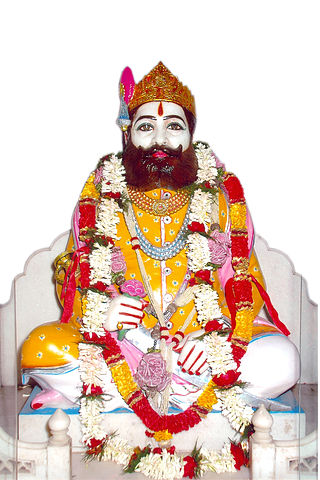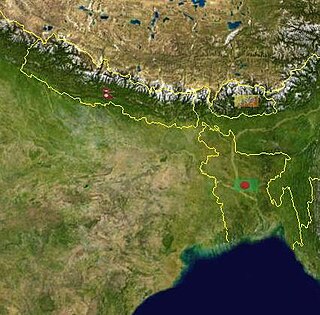Agrahari Sikh is a Sikh community found in Eastern India that includes the States of West Bengal, Bihar and Jharkhand. [1] [2] [3]
| Part of a series on |
| Sikhism |
|---|
 |
Agrahari Sikh is a Sikh community found in Eastern India that includes the States of West Bengal, Bihar and Jharkhand. [1] [2] [3]
Agrahari Sikhs have lived for centuries in Bihar and Jharkhand. In the presence of Guru Sahib, Agraharis adopted the Khalsa Panth for protecting their life and religion.[ citation needed ]
Agrahari Sikhs settled in Sasaram, Gaya in Bihar, Kolkata city of West Bengal, Dumari (Hunterganj), Kedli Chatti (of Jharkhand) and even other places of Bihar and Jharkhand. Agrahari Sikhs moved East of India and are also found in some parts of Uttar Pradesh. [4]

Jharkhand is a state in eastern India. The state shares its border with the states of West Bengal to the east, Chhattisgarh to the west, Uttar Pradesh to the northwest, Bihar to the north and Odisha to the south. It is the 15th largest state by area, and the 14th largest by population. Hindi is the official language of the state. The city of Ranchi is its capital and Dumka its sub-capital. The state is known for its waterfalls, hills and holy places; Baidyanath Dham, Parasnath, Dewri and Rajrappa are major religious sites.

Magahi, also known as Magadhi, is a Indo-Aryan language spoken in Bihar, Jharkhand and West Bengal states of eastern India, and in the Terai of Nepal. Magadhi Prakrit was the ancestor of Magahi, from which the latter's name derives.

The Chota Nagpur Plateau is a plateau in eastern India, which covers much of Jharkhand state as well as adjacent parts of Chhattisgarh, Odisha, West Bengal and Bihar. The Indo-Gangetic plain lies to the north and east of the plateau, and the basin of the Mahanadi river lies to the south. The total area of the Chota Nagpur Plateau is approximately 65,000 square kilometres (25,000 sq mi).

Dhanbad is the second-most populated city in the Indian state of Jharkhand after Jamshedpur. It ranks as the 42nd largest city in India and is the 33rd largest million-plus urban agglomeration in India. Dhanbad shares its land borders with Paschim Bardhaman district and Purulia district of West Bengal and Bokaro, Giridih and Jamtara districts of Jharkhand. The city is called the 'Coal Capital of India' for housing one of the largest coal mines in the country. The prestigious institute, Indian School of Mines is situated in Dhanbad. Apart from coal, it has also grown in information technology.

Munger, formerly spelt as Monghyr, is a twin city and a Municipal Corporation situated in the Indian state of Bihar. It is the administrative headquarters of Munger district and Munger Division. Munger was one of the major cities in Eastern India and undivided Bengal during Mughal period and British Raj. It is one of the major political, cultural, educational and commercial center of Bihar and Eastern India. Munger is situated about 180km from east of capital city Patna, about 480km west of Eastern India's largest city Kolkata and 1200km from country's capital New Delhi.

Damodar River is a river flowing across the Indian states of Jharkhand and West Bengal. The valley is rich in mineral resources and is known for large-scale mining and industrial activity. It was also known as the Sorrow of Bengal because of the ravaging floods it caused in the plains of West Bengal. The construction of several dams on the Damodar and its tributaries has helped control some of the flooding.

The Kharia are an Austroasiatic tribal ethnic group from east-central India. They originally speak the Kharia language, which belong to Austroasiatic languages. They are sub-divided into three groups known as the Hill Kharia, Delki Kharia and the Dudh Kharia. Amongst them, the Dudh Kharia is the most educated community.

Eastern India is a region of India consisting of the Indian states of Bihar, Jharkhand, Odisha and West Bengal and also the union territory of the Andaman and Nicobar Islands. The region roughly corresponds to the historical region of Magadha from which it inherits its various Eastern Indo-Aryan languages.
Baranwal is a part of the larger Bania community of northern India. They originated in north India in the regions today comprising Uttar Pradesh, Bihar, Uttarakhand, Jharkhand and West Bengal. However, today they have a disapora spread across India and the world.

Indian Sikhs number approximately 21 million people and account for 1.7% of India's population as of 2011, forming the country's fourth-largest religious group. The majority of the nation's Sikhs live in the northern state of Punjab, which is the only Sikh-majority administrative division in the world.
The Sikhs are adherents to Sikhism, the fifth largest organized religion in the world, with around 25 million adherents. Sikh History is around 500 years and in that time the Sikhs have developed unique expressions of art and culture which are influenced by their faith and synthesize traditions from many other cultures depending on the locality of the adherents of the religion. Sikhism is the only religion that originated in the Punjab region with all other religions coming from outside Punjab. All the Sikh gurus, many saints, and many of the martyrs in Sikh history were from Punjab and from the Punjabi people. Punjabi culture and Sikhism are mistakenly considered inseparably intertwined. "Sikh" properly refers to adherents of Sikhism as a religion, strictly not an ethnic group. However, because Sikhism has seldom sought converts, most Sikhs share strong ethno-religious ties, therefore it is a common stereotype that all Sikhs share the same ethnicity. Many countries, such as the U.K., therefore misconcievingly recognize Sikh as a designated ethnicity on their censuses. The American non-profit organization United Sikhs has fought to have Sikhs included on the U.S. census as well, arguing that Sikhs "self-identify as an 'ethnic minority'" and believe "that they are more than just a religion".

Agrahari, Agraharee or Agarhari is an Indian Vaishya community, They are the descendants of legendary king Agrasena. Predominantly, they are found in the Indian state of Uttar Pradesh, Madhya Pradesh, Jharkhand, Chhattisgarh and Terai region of Nepal.

The state of Bihar in eastern India, is one of the oldest inhabited places in the world with a history going back 3000 years. The rich culture and heritage of Bihar is evident from the innumerable ancient monuments that are dotted all over the state. Bihar is home to many tourist attractions and is visited by large numbers of tourists from all over the world. Around total 6 million tourists visit Bihar every year.
Bihar is a state situated in Eastern India. It is surrounded by West Bengal to the east, Uttar Pradesh to the west, Jharkhand to the south and Nepal to the north.

Bihar is located in the eastern region of India, between latitudes 24°20'10"N and 27°31'15"N and longitudes 83°19'50"E and 88°17'40"E. It is an entirely land–locked state, in a subtropical region of the temperate zone. Bihar lies between the humid West Bengal in the east and the sub humid Uttar Pradesh in the west, which provides it with a transitional position in respect of climate, economy and culture. It is bounded by Nepal in the north and by Jharkhand in the south. Bihar plain is divided into two unequal halves by the river Ganges which flows through the middle from west to east. Bihar's land has average elevation above sea level of 173 feet.
Bauri (Bengali:বাউরী) is a community of indigenous people primarily residing in Bengal, and considered as one of the Scheduled Castes of India. The Bauris belong to the Bhil tribe. They are usually involved in activities like farming. The Bauris of Purbo Tila Moulvibazar in Bangladesh are usually involved in medicinal practices. The prime festivals they celebrate are known as Mansa Puja, Durga Puja and Kali Puja.

Shershabadia, are a Muslim community found in the state of West Bengal, Bihar and Jharkhand in India. They belong to Shaikh community and also form a significant part of the Shaikhs of West Bengal and Bihar. Common surnames used by the community include Shekh, Sekh, Haque, Islam, Mondal. Most of them are Sunni Muslims who associate with the Ahl-i Hadith movement.
The Kudmi Mahato are a tribal community in the states of Jharkhand, West Bengal and Odisha of India. They are primarily agriculturalist.
Mahto or Mahato is a surname used by several castes and communities in the states of Bihar, Jharkhand, West Bengal, Uttar Pradesh and Odisha in India. Mahato is also a popular surname in Nepal. In the zamindari villages, "Mahto" was a title given to the headman of a village ward. The mahto's duties were to maintain peace in his area, and collect revenue for the zamindar. In Chotanagpur plateau region of Jharkhand, including in the Oraon tribal society, Mahato was historically a title of the village chief. In Bihar, the surname Mahto is primarily used by people belonging to Kushwaha caste. While in Jharkhand, it is a term most often associated with Koeri and Kurmi caste.
The Bengali Language Movement is a campaign to preserve Bengali language and Bengalis culture and to oppose anti-Bengali sentiment in India. The movement was started in Manbhum in 1940, ahead of the Partition of India which allocated eastern Bengal to the new nation of Pakistan and led to the relocation of many Bengali communities. In 1947 British India bifurcated into India and Pakistan. The population of the eastern part of Bengal was majority Muslim, and was incorporated into Pakistan. Bengali Hindus in this eastern region migrated to India, principally settling in West Bengal, Chhattisgarh, Dandakaranya and Odisha, Maharashtra, Karnataka. The Movement remains prominent in Assam, Jharkhand, Bihar, Chhattisgarh and Karnataka.